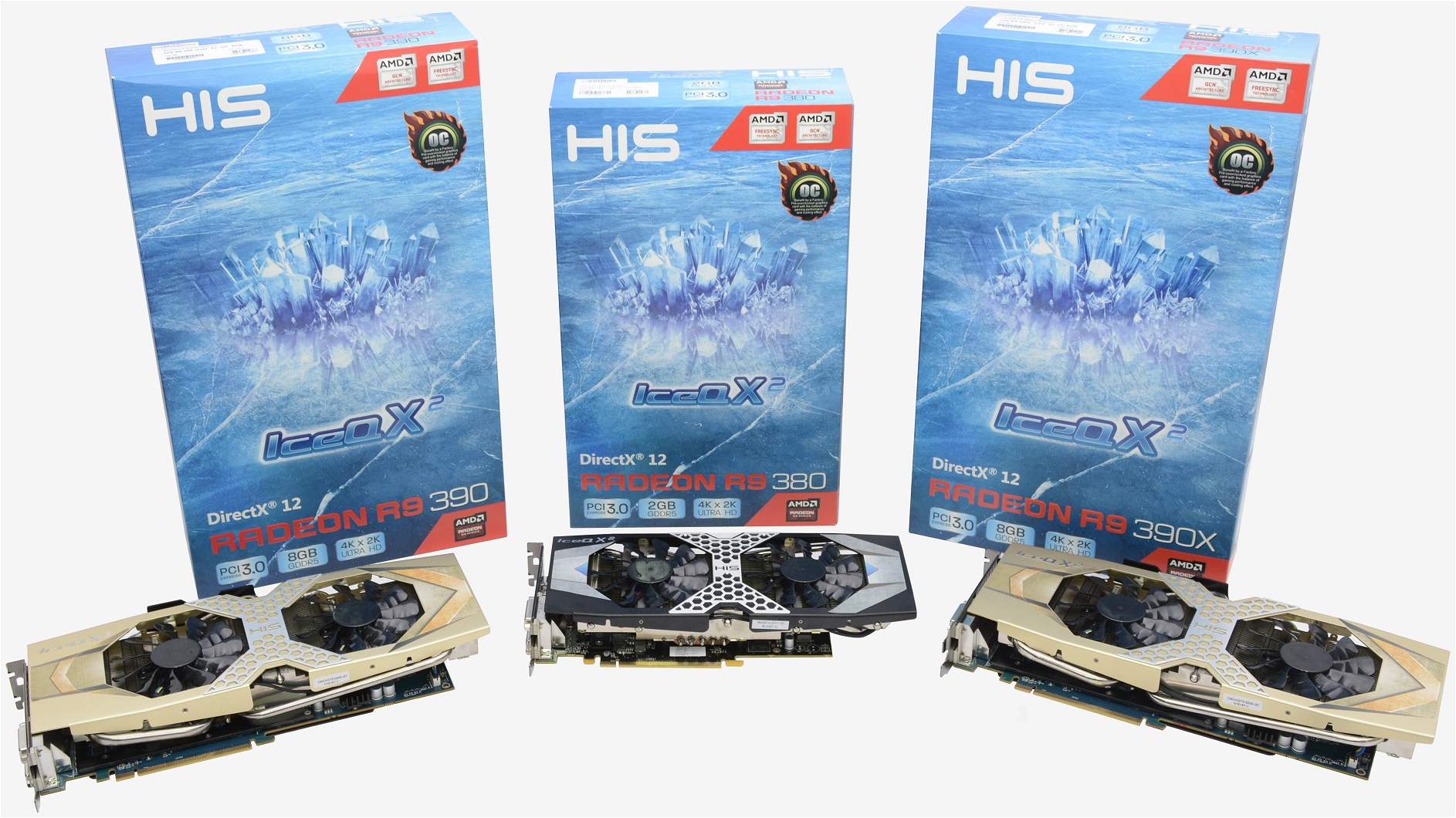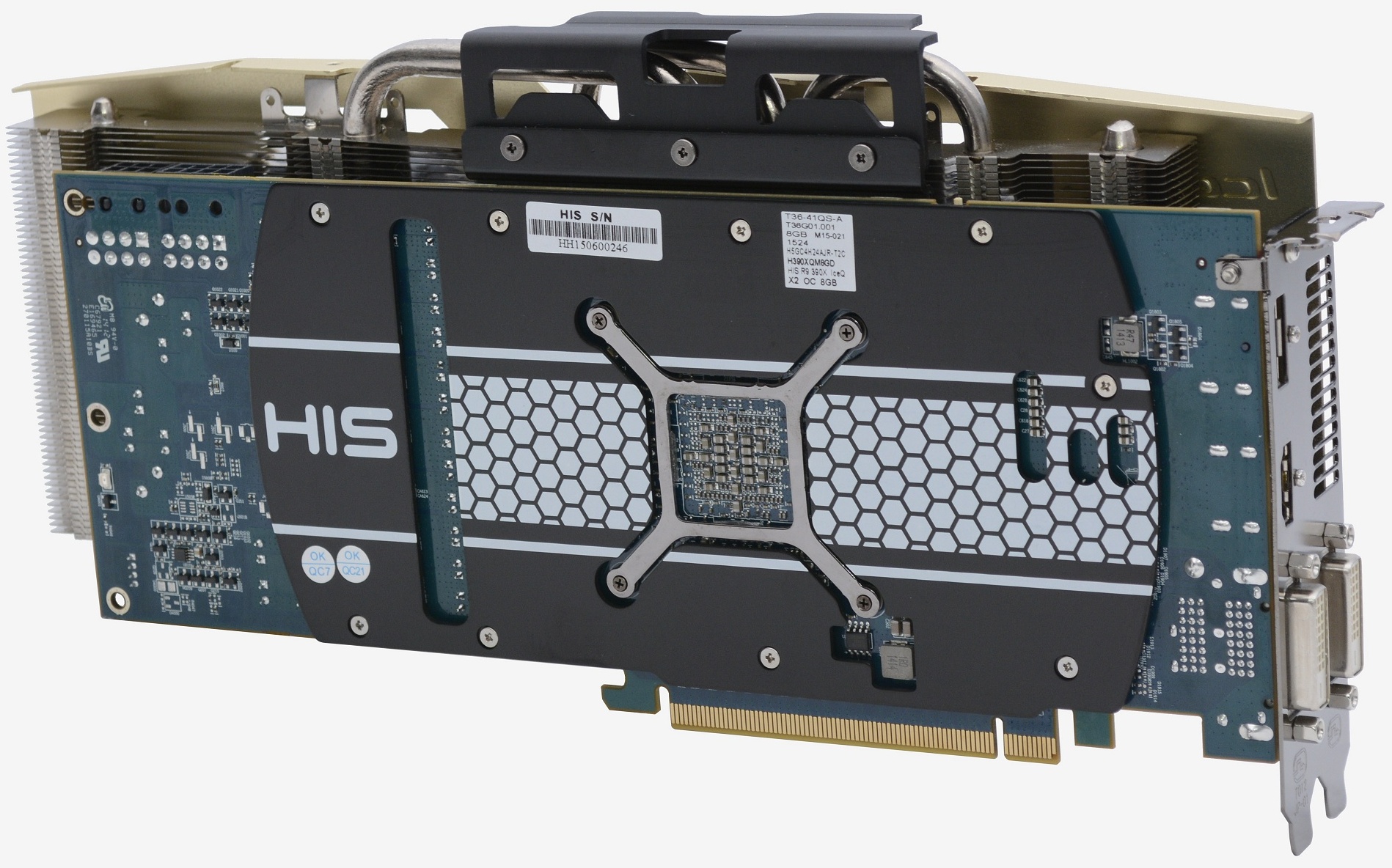HIS IceQ X² OC Radeon R9 390X, R9 390 & R9 380 Review
AMD made great strides in January 2012 when information technology released its first GCN-based GPU. Codenamed 'Tahiti XT', the Radeon Hard disk 7970 squeezed 4.three billion transistors onto a 352 mm2 dice, allowing for 2048 cores and a fill charge per unit of 32 gigapixels per 2d.
Subsequently a long 22 calendar month look, AMD re-released the HD 7970 equally the R9 260X (aka 'Tahiti XT2'), though the newer card really offered less operation as it came with a slightly slower clock speed that ultimately reduced the fill rate from 32 to 27.2GP/south.

AMD showed its terminal Radeon 200 series graphics menu a yr later, but neither the price nor the functioning of the R9 285 'Tonga Pro' was noteworthy. Instead, it was this GPU's adoption of the latest GCN i.two compages that raised eyebrows, though truth be told, few eyebrows were actually raised. The simply products that made the Radeon 200 series worth remembering were the Radeon R9 290 and R9 290X. They took the GCN 1.1 architecture and expanded the die to include more cores and a wider retention passenger vehicle.
With GCN ane.ii providing no real functioning edge over the first two versions, we've been wondering what AMD'due south side by side movement would be. Later all, it's now been three and a half years since GCN was first introduced.
Surprisingly -- or perhaps unsurprisingly for the cynics amongst us -- that next move is yet another round of rebadged Radeons.
Since these first Radeon 300 serial GPUs are rebranded, AMD is ripping the band aid off rapidly by releasing them all together versus trickling them out over the adjacent few month. Today's launch brings the Radeon R9 390X, R9 390, R9 380, R7 370 and R7 360.
The R9 390X is the R9 290X with twice the VRAM (this seems unnecessary) that is clocked a scrap college alongside a slightly higher core frequency. On newspaper this ways a five% increase in GP/s and a twenty% greater retentivity bandwidth.
The R9 390 is much the same, being a clone of the R9 290 with twice the VRAM also every bit higher cadre and retentiveness clock speeds.
The R9 380 is the R9 285 with a few modest upgrades, but performance-wise the R9 380 shouldn't exist much faster than the 3.5 yr erstwhile HD 7950 as they both accept the same core configuration. The R9 380 has a core and memory clock speed advantage but it also suffers i major disadvantage, which we'll get to shortly.
Nosotros had lingering hopes for truly updated GPUs, just what'southward sometime is new again at AMD then say hi to a familiar family of Radeons.
HIS Radeon R9 390X
Comparing the R9 390X to the erstwhile R9 290X on paper, the virtually noticeable difference is the extra VRAM. Whereas the R9 290X was armed with 4GB of memory by default, the R9 390X gets 8GB. For what it'south worth, there are 8GB versions of the R9 290X around and they but toll effectually $xl more than the standard 4GB models.

For a GPU with the same horsepower as the R9 290X, this much VRAM certainly seems to be overkill. The new GTX 980 Ti comes with 6GB of retentivity and is surely going to be faster.
Memory capacity aside, the R9 390X's biggest shot at exceeding the R9 290X's performance rests in memory clock speed as this has been additional by xx% at 6Gbps.
Forth with the memory upgrades, the only other change is a minor adjustment to the cadre clock speed. The default spec at present reads 1050MHz, a 5% increase over the previous 1000MHz speed cap. That said, few lath partners ran their custom cards at the reference clock speeds anyway.

For instance, the HIS IceQ R9 290X Hybrid ran at 1100MHz with the aforementioned 6Gbps GDDR5 clock speed equally the new R9 390X. That particular version from HIS was 12% faster than a standard R9 290X and just 4% slower than the GTX 980.
The new HIS R9 390X IceQ X² OC 8GB looks as though it'southward a special edition card with that huge golden fan shroud, but this is simply an overclocked version and isn't part of a limited edition serial.
Unlike cards based on the AMD reference design, this new HIS graphics carte du jour features a completely unique cooling solution that is considerably more efficient.

As the name suggests, the IceQ X² cooling solution has been employed, though it's a slightly modified version from what we have seen previously. Built with two super large dual 89mm dual centric fans, this dual-slot cooler features a massive heatsink along with iii 6mm and 2 8mm heatpipes linked straight to an extra-large forty x 47.5mm copper base of operations, where they help to improve heat extraction from the GPU.
Connected to the large copper base of the heatsink is a unique RAM rut spreader, which is designed to absurd the GDDR5 modules. HIS claims that this cooler is quieter and more efficient than AMD's reference pattern.

HIS has modified the original IceQ 10² design to include a rear back plate, though nosotros should point out that none of the GDDR5 retention chips are located on the backside of the PCB. Too attached to the rut spreader on the front end is an aluminum plate that extends upwards and over the heatpipes. Apart from looking squeamish, we're not certain what this does. HIS describes it every bit an easy means of carrying the graphics card, which seems strange.

To feed the card enough juice, HIS has gone with a half-dozen-pivot/8-pin PCI Express power connector configuration.
The R9 390X IceQ X² OC 8GB is designed to operate the cadre at up to 1070MHz with 8GB of GDDR5 memory clocked at 6Gbps. Although the AMD spec calls for a GPU clock speed of up to 1050MHz, many custom congenital versions will operate slightly higher than this.
Source: https://www.techspot.com/review/1019-radeon-r9-390x-390-380/
Posted by: mcculloughaskild.blogspot.com


0 Response to "HIS IceQ X² OC Radeon R9 390X, R9 390 & R9 380 Review"
Post a Comment